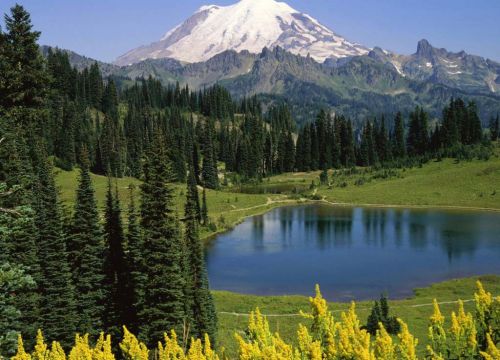
In the summer of 2001 a huge 1300-square-kilometre area in the Altai was declared a national park. It includes almost the entire territory between the borders with Russia and China , the villages of Soldatovo and Medvyedka and the northern slopes of the Sarymsaktiy and Tarbagatay.
Though Katon-Karagay National Park does not have the strictest protective status, it has improved the situation by imposing more severe penalties on poachers and hunters of the endangered species that inhabit this region.
This measure became necessary because of the increasing impact of steadily growing tourism, and because of the increasing exploitation of natural resources by the local population during the 1990s. It's important to note that most of the families in this area's villages are extremely poor; many move out and head for the cities, and the villages begin to stagnate, while those who remain take what they need for their daily survival from the forest.
When traders, mainly Chinese, began 10 come in increasing numbers illegally to buy maral antlers, brown bear bile, and the ascent glands of certain rare species, the temptation to poach animals was strong, as a single animal could garner a poacher the equivalent of a month's income.
Inevitably the wildlife populations of threatened species declined, but as penalties became more severe, poaching has become less appealing.
Other measures have also been employed to combat the problem; the most significant is the successful "farming domestic marals for the medicinal extract pantocrine that is found in abundance in then newly formed antlers.
The region's main town, also called Katon-Karagay is situated on the Narym Valley floor. Small and neat, it has a tiny museum dedicated to the famous Kazakh novelist Oral
Khan Bokeh who was born here and lived in a tiny house that houses the museum, displaying paraphernalia Bokeh's life, including gifts presented to him from admirers during his travels. There is talk of an airport being built in the valley near to Katon-Karagay; this would of course result in development and economic progress for the local population, but responsible tourism growth is a must.
Local officials seem to understand this, and hope to develop tourism models that preserve the ecology and culture while allowing more visitors into the region, improving living standards for local people without causing irrevocable damage to their land.
Rich diversity of flora and fauna and preserved species included in the Kazakhstan Red Book are concentrated here. According to preliminary information there are over 1000 species of vascular plants grow in the park. 30 species are listed as endangered: they are Rhodiola rosea, rapontikum carthamoides, rhubarb Altai, dolgonog snow, anthrax Altaic, Iris Ludwig and others. Main asset of the park woods occupy 34% of the territory and consist mainly of coniferous species. It is fir, cedar, larch and fir, birch and aspen, a large variety of shrubs and dwarf shrubs. Faunal composition represented by 363 species of vertebrates: fish bone (6), amphibians (2), reptiles (6), birds (284), mammals (65). Altai ular, black storks, cranes, gray, belladonna, a burial ground, osprey, saker falcon, peregrine falcon, hawk-nosed scoter, snow leopards, stone martens, trout are in the Red Book. According to the legal regime the territory of the park is divided into the following zones and subzones: reserved mode zone - 1 512.4 sq. km (23,5%); custom mode area - 4 922.4 sq. km (76,5%); subbands: of recreational use, restrictions and economic activities, administrative and economic activities, services for visitors and tourists. The last two subzones are located in settlements outside the national park. The whole territory is divided into 30 sites to protect and restore natural systems.

